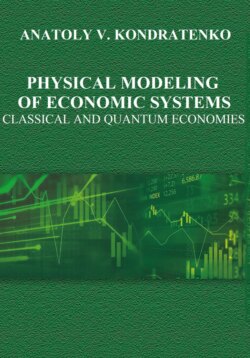Physical Modeling of economic systems

Реклама. ООО «ЛитРес», ИНН: 7719571260.
Оглавление
Anatoly Kondratenko. Physical Modeling of economic systems
PREFACE
1. Introduction
2. Main elements of the physical models
3. Price space
4. Classical economy
5. Quantum economy
5.1. Time-dependent equations of motion of quantum economy
5.2. Stationary equations of motion
5.3. Economy with a single buyer and a single seller
5.4. Probability distribution of conducting transactions by sellers and buyers
5.5. Demand and supply functions
5.6. Probabilistic mechanism of determination of a market price
5.7. Market price and demand and supply elasticities
5.8. System comprising arbitrary numbers of sellers and buyers
5.9. The additivity rule for demand and supply functions
5.10. Excited states of quantum economy
6. Conclusion
References
Отрывок из книги
This is the first monograph in a series devoted to the development of probabilistic economic theory (Kondratenko, 2005, 2015, 2021). It outlines the fundamental concepts of this theory.
Every rational player or market subject acts in the market in accordance with a strict rule of obtaining maximum profit or benefit or some other criterion of optimality for him or her and in this respect market economic systems resemble physical systems where all players, members, and elements of the system act also in accordance with some principles of maximization.
.....
In physics a wide experience in calculating physical systems of different degree of complexity with different interaction between members of the system and the system with external environment has been accumulated. It makes sense trying to find a way to use these achievements in finding solutions of economic problems. In case such an activity were successful, there would appear an opportunity of numerical research of the influence of both different internal and external factors on the behavior of each economic agent and on the results of activity of the whole economic system with the help of computer calculations of physical models. Economics (more exactly – theoretical economics) would obtain the most powerful research device the opportunities of which could be compared with the result of the discovery of equations of motion of the physical systems.
The logic of present research is the following. At the first stage of designing a physical model and deriving equations of motion of economic systems from the first principles, or ab initio, we first make all approximations and assumptions required for deriving equations of motion of physical systems in the course of theoretical physics by Landau and Lifshitz [1, 2], then we obtain economic systems equations which are similar to physical systems equations in form and are considered by us as starting or initial approximation for a physical model of the economic system. At the second stage massive model calculations are carried out, their results are compared with experimental or test results, in other words, with the data of empirical economics. At the same time, some optimum values of model parameters and potentials are obtained and the applicability limits of the given initial approximation are estimated. At the third stage suppositions are estimated comparing calculation results and experimental data, and more precise and appropriate optimization principles and corresponding equations of motion are found.
.....